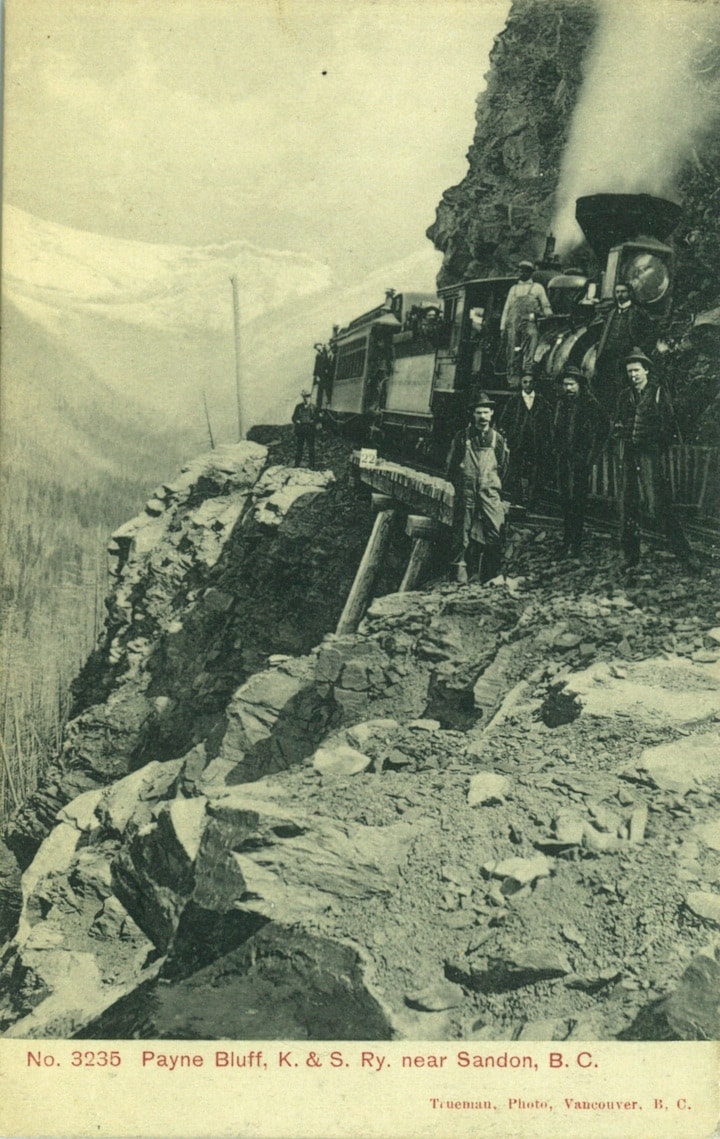First of two parts
Next year marks the 125th anniversary of the start of the Silvery Slocan mining rush, which gave birth to Slocan, Silverton, and New Denver and buoyed the fortunes of West Kootenay generally.
I’m indebted to Chris McNamara of Retallack Lodge for pointing this out. He’s thinking of ways to commemorate the occasion and has already put in a few months researching the original strike that set things in motion.
This story has been told many times, but here’s an overview: on Sept. 9, 1891, after several days of fruitless prospecting, Eli Carpenter and Jack Seaton staked the Payne claim. When they registered it with mining recorder T.H. Giffin 13 days later, they gave its location as “About 25 miles west of Kootenay Lake in the headwaters of Slocan Creek.”
(Oddly, while the name Slocan now applies to a valley, village, river, lake, and mountain range among other geographic features, there is no longer a Slocan Creek.)
Despite its spelling, the Payne was supposedly named after Thomas Paine, the American philosopher and Founding Father. What inspired Carpenter and Seaton to choose that name is a mystery, but there were other Tom Payne mines in Oregon and New Mexico.
In any event, the pair returned to Ainsworth where they had the claim assayed. According to Seaton, Carpenter deceived him about the results.
“My partner brought me the returns and they were only $26 [worth of silver per ton] or so,” Seaton told the Spokane Review in an account which has never been reprinted until now.
“Thinking there was nothing in the find I went back to work in a mine on the east shore of the lake near the Bluebell. In the meantime my partner, who had thrown off on me, got G.B. Wright to send him in by way of the Slocan river to stake out the whole country. The Hennessy boys got on to it and came over to see me about it. Just to satisfy myself I took a sample over to the assayer and got a return of $600 to the ton.”
I’m not sure I buy Seaton’s story for Carpenter was otherwise highly regarded by the local mining fraternity (but then again, so was Seaton). Carpenter said when they reached Ainsworth “Jack swore he would never return and he determined to return alone.”
By any measure, they had a falling out. Carpenter headed back to the Payne via the Slocan River with a new partner, Ernest Bielenberg, hoping to stake additional claims, while Seaton teamed up with Bill and Jack Hennessy, Frank Flint, and Jack McGuigan and went back by way of Kaslo.
The Noble Five, as they called themselves and one of their claims, reached the Payne first on Sept. 25, laying claim to all the best ground. Bill Hennessy and Flint jointly located the Mountain Chief, Jack McGuigan staked the Two Jacks, and Jack Hennessy the Maid of Erin. All three were adjacent to the Payne. Hundreds more were staked by others in the coming days, weeks, and months.
Neither Seaton nor Carpenter became especially wealthy due to the Payne: within two months, Seaton sold his half-interest to Stephen Samuel Bailey for $500 while Carpenter made $500 or $1,000 on his share, which later fell into Bailey’s hands as well. Bailey also paid the Noble Five $10,000 to acquire the Mountain Chief, Maid of Erin, Two Jacks, and Last Chance.
On March 17, 1893, Bailey, Scott McDonald, Alfred W. McCune, and William L. Hodge obtained a crown grant for the Payne, while Bailey received in his name alone the crown grant on the Two Jacks, Mountain Chief, and Maid of Erin. These formed the Payne group.
The Payne shipped small amounts of ore in 1893 and 1895, but didn’t become a going concern until 1898 under the Payne Mining Company of BC Ltd. and then the Payne Consolidated Mining Co.
The bulk of the mine’s production ended in 1906, but additional shipments continued until 1939. The Payne has been poked and prodded ever since, as recently as 2008 when Klondike Silver Corp. took soil samples, and completed geological mapping, surveying, and trenching.
In all, the mine shipped 110,604 tons of ore, from which 116,386,525 grams of silver was extracted (worth $58.5 million at today’s prices), along with 17,376,637 kg of lead, and 1,024,416 kg of zinc.
Its best year in terms of tonnage was 1905 (36,986 tons of ore shipped), and its best year in terms of silver content was 1900 (25,969,014 grams). Between 1897 and 1904, the mine paid dividends of $1.4 million.
What of the Payne’s discoverers?
Jack Seaton drank himself to death in Spokane in 1893. Eli Carpenter continued prospecting in BC, the Yukon, and Australia, with only modest success. He died in 1917 and is buried in an unmarked grave in Salmon Arm. Seaton and Carpenter are, however, both remembered in namesake creeks in the Slocan — Carpenter’s passes through Sandon and New Denver.
Next we’ll look at how the centennial of the Payne’s discovery was marked, and some ideas McNamara has to mark the 125th anniversary.
